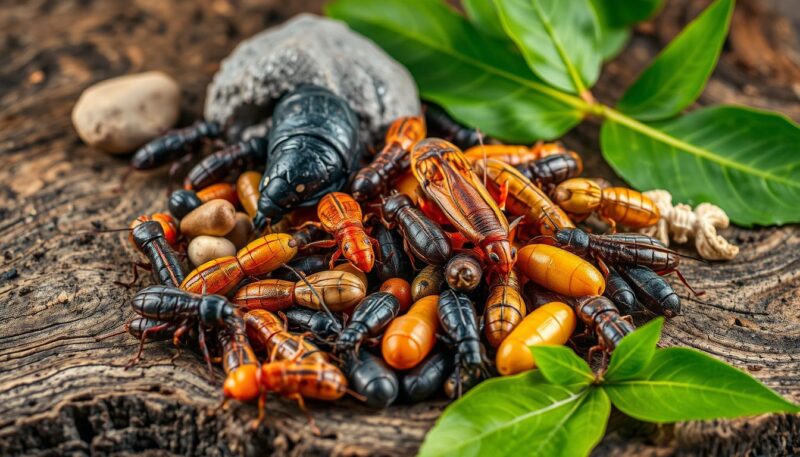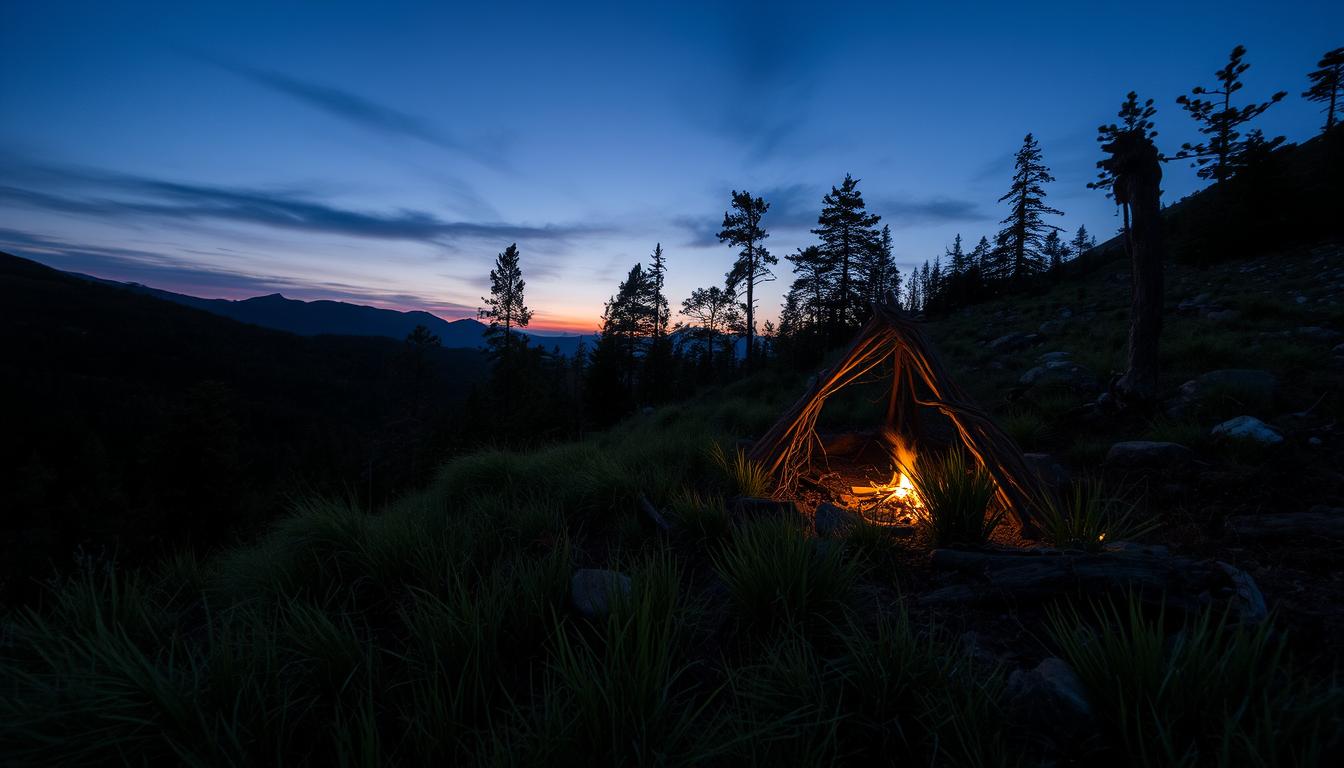When thrust into a survival situation in the wilderness, the pressing question of whether you can eat grass to stave off starvation often arises. While the idea may seem practical given its abundance, wilderness experts advise exploring other options first. The critical nature of emergency foraging emphasizes the need for wisdom in your food choices during times of starvation survival.
Although the potential of consuming grass might cross your mind, it’s vital to understand both its nutritional value and the accompanying risks. The modern-day survivalist must prioritize finding non-hazardous, energy-providing foods to optimize their chances of surviving starvation. Alternative sources from nature—be they plants or insects—could offer better sustenance and fewer risks.
Key Takeaways
- Grass isn’t the most nutritious option in a survival situation.
- Wilderness experts suggest alternative wild foods over grass.
- Dandelions, fireweed, and cattails offer more nutrients and are safer.
- Identifying non-hazardous wild edibles is crucial in starvation survival.
- Emergency foraging requires both wisdom and survival skills.
The Survival Rule of Three: Prioritizing Oxygen, Shelter, Water, and Food
Understanding the importance of survival priorities is essential if you find yourself in a life-threatening situation. Known as the “Rule of Three,” this principle provides a guideline for prioritizing your immediate needs in survival scenarios. Let’s dive deeper into this rule, why food takes a lower priority, and the challenges of energy maintenance in survival situations.
Understanding the Rule of Three
The Rule of Three sets the hierarchy of survival scenarios: you can survive for 3 minutes without oxygen, or in icy water, about 3 hours without shelter in a harsh environment, up to 3 days without water if you have shelter, and approximately 3 weeks without food. This rule underscores the urgency of securing oxygen first, shelter second, water third, and food last.
Why Food is Lower on the Priority List
In survival scenarios, food is often lower on the priority list because maintaining oxygen, shelter, and water are more critical for immediate survival. While an average adult can survive for three weeks without food, energy maintenance in survival becomes crucial to perform tasks like building a shelter and procuring water. The diminishing capability over time makes the act of finding food important but not as immediate as other survival priorities.
The Challenges of Maintaining Energy in Survival Situations
Energy maintenance in survival situations presents significant challenges as the body requires a steady intake of nutrients to function optimally. Without regular food intake, tasks such as shelter building, water collection, and maintaining core body temperature become more arduous. Knowing how to build a survival shelter, for example, can conserve your energy and protect you from the greatest risk in a survival scenario, hypothermia.
| Survival Priority | Effective Time without It | Consequences |
|---|---|---|
| Oxygen | 3 minutes | Fatal within minutes |
| Shelter | 3 hours | Risk of hypothermia or hyperthermia |
| Water | 3 days | Severe dehydration and death |
| Food | 3 weeks | Gradual decline in physical and mental function |
Common Edible Plants in the Wild That Can Keep You Fed
Surviving in the wilderness hinges on your knowledge of edible plants and wild plant safety. Knowing which plants to consume can be the difference between sustenance and potential harm. Below are some common edible plants you can find in the wild that are both nutritious and safe.
Dandelions: Nutritious and Ubiquitous
Dandelions are among the most easily recognizable edible plants in nature. They are ubiquitous and can be found across the United States. All parts of the dandelion, including the leaves, roots, and flowers, are edible and packed with vitamins A, C, and K, as well as minerals like calcium and potassium. When foraging for dandelions, ensure that the area is free from pesticides to adhere to wild plant safety guidelines.
Fireweed: A Common and Edible Plant
Fireweed stands out in the wild due to its vibrant purple blooms and is a common sight in the wilderness. This hardy plant is not just beautiful; all parts of fireweed are edible. Its young shoots can be eaten raw, steamed, or sautéed. The leaves and flowers can be added to salads, and the roots can be roasted for a chewy, nutrient-dense snack. Fireweed is an excellent source of vitamin C and beta-carotene and is often used by Native Alaskan tribes for its medicinal properties.
Cattails: More Than Just the Root Is Edible
Often found near water sources, cattails are incredibly versatile edible plants. While the roots are rich in starch and can be roasted or boiled, several other parts of the cattail are also edible. The young shoots, often called ‘cossack asparagus,’ can be eaten raw or cooked. The pollen, which can be collected in late spring and early summer, can be used as a flour substitute. Remember to practice wild plant safety by correctly identifying cattails before consumption, as they often grow near toxic look-alikes such as blue-green algae.
Knowing and identifying these edible plants can significantly boost your chances of sustenance and survival in the wilderness. Always ensure that you properly distinguish these plants to avoid the dangers associated with toxic flora.
Can You Eat Grass if You’re Starving?
When stranded in the wilderness, finding food can become a priority that drives you toward unconventional sources. One common survival suggestion is grass, but how viable is this option? Here we delve into grass survival myths, its nutritional value, potential risks, and sought-after wilderness survival recommendations to unveil the reality of using grass as food.
The Nutritional Value of Grass: Facts and Myths
It’s essential to distinguish between myth and reality when considering grass as a food source. While over 400 types of grasses worldwide are technically edible, including nutritional components like proteins, chlorophyll, magnesium, phosphorus, iron, calcium, potassium, and zinc, the nutritional gain for humans is minimal. For instance, species such as barley grass, wheatgrass, and alfalfa offer some benefits, yet the human digestive system struggles to process these adequately due to the high cellulose content.

Additionally, cereals within the grass family, such as wheat, rice, and oats, provide better nutritional profiles through their seeds rather than their blades. However, relying on grass alone overlooks the more nutritionally beneficial wild edibles available.
Potential Risks and Drawbacks
The most notable risk of consuming grass lies in its indigestibility due to high cellulose levels, which the human digestive system can’t break down efficiently. Consequently, eating large amounts may lead to digestive distress and could even cause severe illness. Furthermore, certain grass seeds can be toxic if not correctly identified, adding another layer of risk when considering grass as food.
Cows need to consume over 30 pounds of grass daily to sustain themselves, illustrating the low nutrition provided. Such overconsumption is impractical and inefficient for humans in survival situations.
Recommendations from Wilderness Experts
Experts in wilderness survival strongly recommend against relying on grass as a primary food source. Instead, focus on more nourishing and safe alternatives. Plants like dandelions, cattails, and various conifers offer higher nutritional benefits and are easier for humans to digest. Even in urgent situations, seeking out such edible plants can make the difference between mere survival and maintaining your health.
Moreover, survival specialists advocate preparedness. Understanding local edible flora and carrying emergency food supplies can significantly improve your survival chances. Ultimately, grass survival myths often oversimplify the complex needs of the human body in an emergency, underlining the critical importance of educated and well-researched wilderness survival recommendations.
Alternative Wild Foods: Insects, Roots, and Other Natural Sources
In the wild, surviving on nature’s food can be a blend of adventure and necessity. From protein-packed insects to nutrient-rich wild roots and safe wild edibles, understanding the options available can significantly enhance your survival toolkit.
Insects: A Nutritious and Readily Available Option
Insects as food might seem unconventional, but they offer a surprisingly high nutritional value. Termites, for instance, can provide up to 6 calories per gram. Grasshoppers, ants, and crickets are not only rich in protein but can be found abundantly. However, ensuring foraging safety by correctly identifying edible species is crucial to avoid toxic varieties.

Harvesting Roots Safely
Wild roots such as burdock, cattails, and Jerusalem artichokes present another alternative to sustain you in a survival situation. While these wild roots can be nutritional powerhouses, it’s essential to practice foraging safety. Proper identification and knowledge of harvesting methods are vital to avoid poisonous look-alikes.
Finding and Preparing Safe Wild Edibles
Identifying and preparing safe wild edibles require a balance of knowledge and experience. High-calorie foods like starchy roots, tree nuts, and berries should be focused on, particularly during survival efforts. The advice on ethical harvesting and understanding seasonal availability will help mitigate periods of scarcity and maximize your efforts during feast times.
Foraging for safe wild edibles means you need to be aware of the environment, look for telltale signs, and ensure sustainable practices. Mastering this art ensures you gather nature’s food efficiently and safely, adding variety and nutritional balance to your survival diet.
Top Survival Myths Debunked by Experts
The world of survival is filled with misconceptions that can spell disaster if taken at face value. It’s essential to separate fact from fiction to ensure your survival and well-being in critical situations.
The Myth of Surviving Solely on Natural Foods
One of the most pervasive survival myths is the notion that you can live entirely off natural foods. Experts argue that this belief overlooks the complexity of a balanced diet. While edible plants and insects can provide some nutrients, they often lack essential fats and proteins. Without these crucial components, your body cannot sustain long-term energy and health. Take, for instance, survival tv shows like Alone where participants struggle to source adequate fat to maintain their body weight. Reality check: For optimal survival, you need more than just foraged greens.
Understanding the Importance of Fat in Your Diet
The importance of fat in diet is frequently underestimated in survival scenarios. Fat is vital for absorbing certain vitamins and providing long-lasting energy. Consuming lean meats without any fat can lead to “rabbit starvation,” a condition that strips your body of energy reserves. Therefore, ensuring your survival skill set includes the knowledge to source and prepare foods rich in fats is crucial. Whether you’re in the wild or stranded in rugged terrain, understanding this key dietary aspect can mean the difference between life and death.
The Reality of Survival Situations and Skill Sets
Many survival myths also revolve around the feasibility of tasks and expectations during a survival emergency. The romanticized view of self-reliance often glosses over the breadth of the survival skill set required to genuinely thrive. From foraging to shelter-building and navigation, hands-on experience significantly outweighs theoretical knowledge. As experts emphasize, practicing these skills in controlled environments can prepare you for real-life scenarios where time and conditions might not be on your side. Reality demonstrates that survival is not only about knowledge but also about execution under pressure.
In summary, debunking these survival myths and understanding the importance of fat in diet, as well as mastering a comprehensive survival skill set, can elevate your preparedness to new levels. Trust the advice from experts who have navigated these challenges firsthand.
Conclusion
With this final survival advice in mind, it’s essential to acknowledge that surviving in the wild requires a blend of expert wilderness guidance, adaptability, and sound knowledge. This journey isn’t just about the skills; it’s a testament to human resilience and resourcefulness. Addressing common survival myths, understanding the nutritional challenges, and knowing which wild foods are safe to consume empower you to navigate nature with confidence.
Your final survival thoughts should center on prioritizing essential needs following the Survival Rule of Three. While water and shelter are immediate necessities, food, including potential plant and insect sources, becomes critical over time. However, as the debate around consumable grasses highlights, not all greenery offers nutritional value. Humans cannot derive meaningful sustenance from common grasses due to their high cellulose content and our inability to digest it.
Ultimately, remembering that your knowledge and preparedness are the keystones of endurance is vital. Educating yourself on edible plants, understanding the importance of a balanced diet in survival, and debunking myths ensures you’re well-equipped to tackle the wild. These concluding survival thoughts reinforce the importance of expert wilderness guidance, emphasizing that survival is a test not just of skill, but of the human spirit’s boundless capacity to adapt and thrive in nature.
FAQ
Can you eat grass if you’re starving?
While grass is abundant, it is not the most nutritious or safest option. Humans cannot effectively digest the cellulose in grass, which may result in negligible nutritional benefits and potential health risks. Wilderness experts recommend seeking alternative wild edibles.
What is the Rule of Three in survival scenarios?
The Rule of Three highlights critical survival priorities: you can survive approximately 3 minutes without oxygen, 3 hours without adequate shelter in extreme weather, 3 days without water, and up to 3 weeks without food. Understanding this helps prioritize actions in survival situations.
Why is food lower on the priority list in survival situations?
While food is vital for sustained energy, having adequate shelter and water is more immediately crucial. Maintaining energy through wise food choices allows you to perform critical survival tasks, such as building shelter and procuring water.
Why is maintaining energy challenging in survival situations?
In the wild, you expend a lot of energy building shelter, finding water, and trying to secure food. Additionally, the scarcity of easily accessible, nutrient-rich food sources makes energy maintenance a significant challenge.
What are some common edible plants in the wild that can keep you fed?
Dandelions, fireweed, and cattails are among the wild edible plants to look for. Dandelions are nutrient-dense and ubiquitous. Fireweed is common and all parts are digestible, while cattails provide several edible components and are rich in starch.
What are the nutritional values and myths related to grass?
Grass contains cellulose which humans cannot digest effectively, leading to minimal nutritional value. Myths often exaggerate the benefits of grass consumption, but experts advise caution and opting for alternatives for better sustenance.
What are the potential risks and drawbacks of eating grass?
Eating grass can lead to digestive issues since humans lack the enzymes needed to break down cellulose. Additionally, some grasses may contain harmful pesticides or toxins, posing further health risks.
What do wilderness experts recommend about eating grass?
Wilderness experts caution against relying on grass as a food source. Instead, they recommend seeking out more suitable and nutritious wild edibles like certain plants, insects, and roots.
Are insects a viable food source in the wild?
Yes, insects are a protein-rich and abundant food source. They can provide essential nutrients, but caution is needed to avoid toxic species. Proper identification and preparation are key to safely consuming insects.
How can one safely harvest roots in a survival situation?
To safely harvest roots, ensure you correctly identify the plant species, as some can be toxic. Knowledge of local flora and safe foraging practices are crucial to safely incorporating roots into your diet.
What are some tips for finding and preparing safe wild edibles?
Identifying, harvesting, and preparing wild edibles requires knowledge and practice. Study local edible plants, learn to distinguish them from toxic ones, and understand safe preparation methods to make wild foods safe for consumption.
What are some common survival myths debunked by experts?
One myth is that you can survive solely on natural foods, but dietary fat is crucial for digesting lean meats. Another myth is the feasibility of maintaining a normal productivity pace for survival projects, which is often impractical due to limited time and resources.
Why is dietary fat important in survival situations?
Fat is essential for energy and for processing proteins efficiently. In survival conditions, rationing fat and finding fat-rich food sources are crucial to sustain energy and vital functions.
What is the reality of survival situations according to experts?
Survival situations demand a diverse set of skills and practical experiences. Hands-on bushcraft, as opposed to theoretical knowledge, prepares you to handle real-life challenges effectively. Adaptability, preparedness, and wisdom are keystones to endurance.
Source Links
- https://www.tactical.com/wilderness-survivalism-food/
- https://www.npr.org/sections/goatsandsoda/2016/01/20/463710330/what-happens-to-the-body-and-mind-when-starvation-sets-in
- https://www.trailhiking.com.au/safety/how-to-build-a-survival-shelter/
- https://bushcraftbuddy.com/basic-bushcraft-skills/
- https://americanadventurist.com/forum/threads/wilderness-survival-101.516/
- https://www.backpacker.com/survival/12-edible-bugs-that-could-help-you-survive/
- https://mdc.mo.gov/sites/default/files/2022-01/WildEdibles.pdf
- https://wildernessawareness.org/articles/survival-food-plants-cattail-acorns-grasses-and-conifers/
- https://simplefamilypreparedness.com/can-ypu-eat-grass/
- https://www.trainerroad.com/forum/t/hungry-at-night-and-post-exercise-eating-advice-please/10685
- https://www.offgridweb.com/survival/the-myth-of-subsisting-on-nothing-more-than-wild-plants/
- https://www.twineagles.org/survival-food-list.html
- https://www.theguardian.com/environment/2019/nov/20/to-eat-or-not-to-eat-10-of-the-worlds-most-controversial-foods
- https://www.artofmanliness.com/skills/outdoor-survival/podcast-869-the-survival-myths-that-can-get-you-killed/
- https://en.wikipedia.org/wiki/List_of_common_misconceptions
- https://www.livenowthrivelater.co.uk/2013/10/why-eat-grass-fed-beef/
- https://www.primalsurvivor.net/can-humans-eat-grass/
- https://modernsurvivalonline.com/eating-grass-to-survive/

